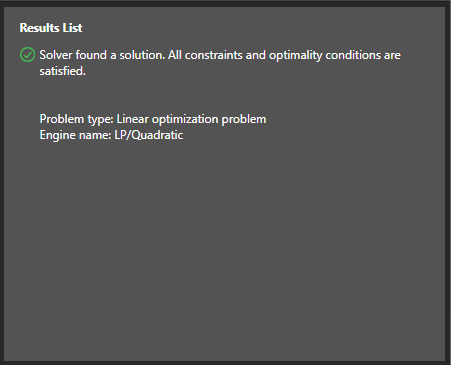This task describes how to use the Solve plug-in to find an optimized value for a particular "objective" cell (a minimum, maximum, or specific value), based on decision variables and constraints in the Tabulate spreadsheet.
For example, you can use Tabulate to model your decision variables such as your marketing or stock budgets, and constraints like batch sizes for stock items, and then run Solve to see how (given your constraints) your projected profit might be maximized.
Step 1: Open the Solve panel
Using Tabulate Pro:
-
From the ribbon at the top of the page, click Advanced Settings > Solve (green).

Note: The Solve button is only shown on this Tabulate ribbon if your profile enables Solve. For more information, see Pro User Profile.
The Solve panel opens at the bottom of the Tabulate page. The Equations tab is open by default.

-
Optionally, drag the top edge of the panel to resize it.
Step 2: Define your Problem and its Constraints
-
Specify the Optimization Objective you want to achieve.
You need to select how to optimize your value (maximize it, minimize it, or set it to a particular value), indicate which cell contains the value that you are optimizing (this is your "objective cell" and contains your formula), and then indicate the cells that contain the "decision variables" that you want Solve to change to achieve your objective.For more information, including information about the two "quick constraints" checkboxes, see Solve the Optimization Objective.
-
Next, specify any Constraints that apply to the problem.
For example, your suppliers may demand a minimum spend on some material purchases that you need to make. You can select the cell that contains this limited value and indicate that it must remain "greater than" your known minimum spend amount.
For more information, see Solve Constraints.
Note: Quick constraints and constraints may conflict! If a quick constraint defined in the Optimization Objective panel and an explicit constraint defined in the Constraints panel conflict (for example, where "All Values Are Greater than Zero" is selected but one of the cells also has a
<= -3constraint), the explicit constraint takes precedence over the quick constraint. Where the constraints are not in conflict, they both apply. -
Optionally, click the Advanced tab.
The Advanced Methods are displayed at the bottom of the page. These settings allow you to optimize your solution by selecting appropriate methods to use and constraints to apply.

For example, select Ignore Integer Constraints to try to make the problem easier to solve by ignoring the fact that constraints contain integers. You can also set other limits, such as on the maximum time, or number of iterations, that you want Solve to take to try and find the optimal solution.
For more information, see Advanced Methods.
Step 3: Run the Optimization
-
Once you have finished specifying the problem, click Apply or Apply and close to run Solve.
Running Solve applies your selections. Details of the optimization process are shown in the Results List and the actual results of the optimization are displayed in the Tabulate spreadsheet.
